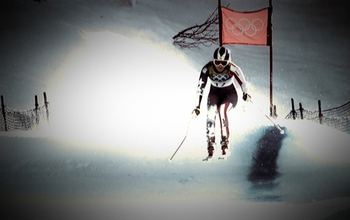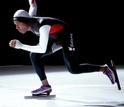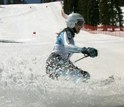News Release 14-004
Enlightening video stories reveal science and engineering behind the 2014 Winter Olympic Games
National Science Foundation and NBC News highlight how physics, engineering, chemistry, design and mathematics impacts the Winter Olympic Games

Research could help Olympic athletes like Lindsey Vonn recover faster from knee ligament damage.
January 9, 2014
This material is available primarily for archival purposes. Telephone numbers or other contact information may be out of date; please see current contact information at media contacts.
The National Science Foundation (NSF) recently partnered with the educational arm of NBC News, NBC Learn, to release a 10-part video series called, "Science and Engineering of the 2014 Olympic Winter Games."
The videos are the latest installment in NSF's and NBC Learn's Emmy Award-winning "Science of Sports" series. Narrated by NBC Sports' Liam McHugh, the enlightening and educational video collection delves into the physics, engineering, chemistry, design and mathematics behind the world's foremost sporting event.
The segments feature a variety of sports stories, as told by some of the world's top athletes and record holders, along with perspectives and innovative research from leading NSF-supported engineers and scientists. The series' diverse topics reveal how key engineering and science concepts and cutting-edge technology play an integral part in each athlete's respective sport and help maximize their performance at the 2014 Sochi Games.
"These stories demonstrate the interplay between sports and engineering, in areas from robotics to medical treatments," said Pramod Khargonekar, NSF assistant director for Engineering. "We hope the impressive feats of athletes and engineering researchers will engage and inspire young people, as they see how engineering technologies can change many facets of our lives."
"The Olympics inspire us and capture our imaginations in many different ways," added F. Fleming Crim, assistant director for NSF's Mathematical and Physical Sciences Directorate. "These videos build a connection between the wonder of athletic accomplishment and the wonder of scientific insight. They will both motivate and fascinate those who see them."
NSF's Directorate for Mathematical and Physical Sciences and its Directorate for Engineering funded the project.
"We are very excited to release this special series, as the Sochi Olympics nears and build on our innovative partnership with NSF," said Soraya Gage, general manager of NBC Learn. "Viewers will be able to watch and learn how science and design concepts play an essential role in the Olympic experience."
New "Science and Engineering of the 2014 Olympic Winter Games" videos released today include:
1. Science of ice: Britanny Bowe, J.R. Celski, Gracie Gold
The science that makes ice slippery also makes the Olympic Winter Games possible. But exactly what makes ice slippery? Ken Golden, a mathematician at the University of Utah, explains how the unique surface of ice makes the slide and glide of winter sports possible.
2. Alpine skiing and vibration damping: Heath Calhoun, Julia Mancuso
Kam Leang, a professor at the University of Nevada, Reno, and Tom Watson, of Watson Performance in Hood River, Ore., describe how advanced materials and engineering help reduce unwanted vibration, optimizing the performance of athletes.
3. Olympic movement and robotic design: Julie Chu, Meryl Davis, Charlie White, Shaun White
Professor Raffaello D'Andrea at the Swiss Federal Institute of Technology in Zurich, Switzerland, describes how control systems engineering is laying the groundwork for the design of more "athletic" robots.
4. Figure skating physics: Meryl Davis, Gracie Gold, Evan Lysacek, Ashley Wagner, Charlie White
Figure skating has become one of the most popular events at the Winter Olympics. Head of the Physics Department at the University of Michigan Brad Orr explains that good balance, or stability, is basic to everything a skater does--and that begins with understanding the center of mass.
5. Engineering competition suits: Shani Davis
At the 2014 Olympics, long track speed skater Shani Davis will be wearing what may be one of the most advanced competition suits ever engineered. Under Armour Innovation lab's Kevin Haley and polymer scientist and engineer Sarah Morgan, of the University of Southern Mississippi, explain how competition suits help improve athlete performance by reducing friction and improving aerodynamics.
6. Physics of slopestyle skiing: Nick Goepper
Jordan Gerton, a professor of physics at the University of Utah describes how Nick Goepper, a 2013 world champion slopestyle skier, will need to follow the laws of physics and rotational motion in order to nail his gravity-defying tricks in Goepper's quest for Olympic gold in this freestyle skiing event debuting in Sochi.
7. Engineering faster and safer bobsleds: Steve Holcomb, Steve Langton
Michael Scully, of BMW DesignWorks USA, and mechanical engineer Mont Hubbard, professor emeritus at the University of California, Davis, explain the engineering challenges associated with making sleds faster and tracks safer.
8. Science of snow: Ted Ligety, Heather McPhie
Snow is an essential part of the 2014 Olympics. How it's formed and how it reacts has been studied by scientists for centuries and continues to this day. Sarah Konrad, a former Winter Olympian who is also a glaciologist at the University of Wyoming, along with Cort Anastasio, a chemistry professor at the University of California, Davis, discuss how humidity and temperature help form snow.
9. Injury and recovery: Lindsey Vonn
Biomedical engineer Cato Laurencin, at the University of Connecticut Health Center, describes his pioneering work in tissue regeneration, a field of research that could help athletes recover faster from knee ligament damage, the same injury that will cause alpine ski racer Lindsey Vonn to miss the Sochi Olympics.
10. Engineering the half pipe: Shaun White
Mechanical engineer Brianno Coller, a professor at Northern Illinois University, explains how engineers design the half pipe so that snowboarder Shaun White can get more air time and allow him to perform tricks.
Each episode is available cost-free to teachers, students and the public at NBCLearn.com and NSF websites (NSF.gov, Science360.gov), accompanied by both science and engineering-focused lesson plans developed by the National Science Teachers Association (NSTA) for middle- and high-school teachers.
"Teachers are always looking for new and innovative ways of cultivating student interest in science, technology, engineering, and math," said David Evans, NSTA executive director. "The 'Science and Engineering of the 2014 Olympic Winter Games' videos provide teachers with an opportunity to connect their curriculum to real-world applications, which enhances student engagement and provides examples of how their learning is linked to events happening outside the classroom."
For other Emmy Award-winning videos produced in partnership with NBC Learn, see: Science of the Olympic Winter Games 2010, Science of the Summer Olympics: Engineering in Sports, Science of NFL Football, Science of NHL Hockey, Science Behind The News, Changing Planet, Sustainability: Water, Science of Innovation, and Chemistry Now.
-NSF-
-
Long track speed skater Shani Davis will be wearing an advanced competition suit.
Credit and Larger Version -
The science of snow--how it's formed and how it reacts has been studied by scientists for centuries.
Credit and Larger Version -
Today's robots can learn to execute complex movements just like Olympic athletes.
Credit and Larger Version
Media Contacts
Bobbie Mixon, NSF, (703) 292-8485, email: bmixon@nsf.gov
Brianne Beers, NBC News, (212) 664-3875, email: brianne.beers@nbcuni.com
The U.S. National Science Foundation propels the nation forward by advancing fundamental research in all fields of science and engineering. NSF supports research and people by providing facilities, instruments and funding to support their ingenuity and sustain the U.S. as a global leader in research and innovation. With a fiscal year 2023 budget of $9.5 billion, NSF funds reach all 50 states through grants to nearly 2,000 colleges, universities and institutions. Each year, NSF receives more than 40,000 competitive proposals and makes about 11,000 new awards. Those awards include support for cooperative research with industry, Arctic and Antarctic research and operations, and U.S. participation in international scientific efforts.
Connect with us online
NSF website: nsf.gov
NSF News: nsf.gov/news
For News Media: nsf.gov/news/newsroom
Statistics: nsf.gov/statistics/
Awards database: nsf.gov/awardsearch/
Follow us on social
Twitter: twitter.com/NSF
Facebook: facebook.com/US.NSF
Instagram: instagram.com/nsfgov





